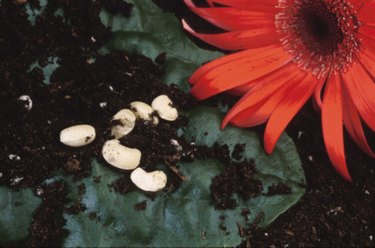
Most plants grow best in neutral soil with a pH that ranges from 6.5 to 7. Levels less than 7 are acidic and levels over 7 are alkaline. Soil's pH level affects the amount of nutrients plants can absorb. After testing your soil to determine its pH, use soil amendments such as sphagnum peat or organic mulch to increase acidity or wood ash to increase alkalinity. Alternately, choose species of plants that prefer acidic or alkaline soils.
Trees
Video of the Day
Several species of trees grow well in acidic soil, including the American beech (Fagus grandifolia), black gum (Nyssa sylvatica), dogwoods (Cornus spp.), Japenese cryptomeria (Cryptomeria japonica), many pines (Pinus spp.), redbay (Persea borbonia), pin oak (Quercus palustris), willow oak (Q. phellos) and Yoshino cherry (Prunus x yedoensis).
Video of the Day
Species that tolerate alkaline soils include European hornbeam (Carpinus betulus), honeylocust (Gleditsia triacanthos), most maples (Acer spp.), northern and southern catalpas (Catalpa speciosa and C. bignonioides) and Serbian spruce (Picea omorika).
Shrubs
Shrubs can be grown as hedges or used to line borders and walkways. Acid-tolerant species include the American snowbell (Styrax Americana), Burkwood oshmanthus (Osmanthus x burkwoodii), Chinese photinia (Photinia davidiana), fothergilla (Fothergilla major), Japanese pieris (Pieris japonica), most azaleas (Rhododendron spp.), inkberry (Ilex glabra) and ixora (Ixora coccinea). Shrubs that grow well in alkaline soil include arrowood (Viburnum dentatum), glossy abelia (Abelia x grandiflora), boxwood (Buxus microphylla), cranberry cotoneaster (Cotoneaster spiculatus (cranberry cotoneaaster), many junipers (Juniperus spp.), spreading cotoneaster (C. divaricatus) and wayfaring viburnum (V. lantana).
Ground Covers
Ground covers fill in bare spots and control weeds. Acid-loving species include dead nettle (Lamium maculatum), periwinkle (Vinca minor), speedwell (Veronica repens), stonecrop (Sedum spp.), sweet woodruff (Galium odoratum) and wormwood (Artemisia spp.). Alkaline-tolerant ground covers include cranesbill (Geranium spp.), cypress spurge (Euphorbia cyparissias), purple rock cress (Aubrieta deltoidea) and rock rose (Helianthemum nummularium).
Ornamental Grasses
Ornamental grasses come in a variety of heights, textures and soil preferences. For acidic sites, choose fountain grass (Pennisteum alopecuroides), purple moor grass (Molinia caerulia), ribbon grass (Phlaris arundinacea) and tufted hair grass (Deschampsia caespitosa). Alkaline-tolerant grasses include blue oats grass (Koeleria glauca), giant reed (Arundo donax) and sideoats gramma (Bouteloa cutipendula).
Perennials
Perennials live for at least three seasons. Many bloom with colorful flowers, though some are grow solely for foliage. Most perennials prefer a slightly acidic soil with a pH from 6 to 6.8, but some thrive in even more acidic sites. These include creeping phlox (Phlox subulata), Japanese roof iris (Iris tectorum), obedient plant (Physostegia virginiana) and primrose (Primula veris). Perennials that tolerate alkaline soil include bee balm (Monarda spp.), bugleweed (Ajuga spp.), daylilies (Hemerocallis), pinks (Dianthus alpinus) and many sages (Salvia spp.).
- Iowa State University Extension; How to Change Your Soil’s pH; Eldon Everhart; April 6, 1994
- Virginia Cooperative Extension; Trees and Shrubs for Acid Soils; Bonnie Appleton, et al.
- Michigan State University: Alkaline-Tolerant Plants
- Ohio State University; Herbaceous Groundcovers for the Home Landscape; Jack Kerrigan, et al.
- University of Kentucky; Ornamental Grasses for Kentucky Landscapes; Lenore J. Nash, et al.; January 2006
- NC State University: Select Perennial Flowers for North Carolina
- Utah State University; What is pH?; Nancy Mesner, et al.; December 2010